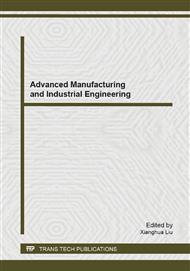p.280
p.285
p.290
p.294
p.298
p.304
p.308
p.313
p.317
Dynamic Analysis on Flexible Cable-Driven Parallel Mechanism
Abstract:
The interference between cables and surface of acutator limits the movement in the cable-driven parallel mechanism. The mechanism with fixed hinge can’t absolutely avoid the interference point of the track when using linear programming method. One new method, named as distant interference, was proposed to pick out all the interferential points of the track. Based on the principle of symmetrical force, the alteration to position of the six fixed hinges and two extensive hinges eliminated the interference. Through the simulation of combined spiral movement, the workspace of the flexible cable-driven parallel mechanism is larger than that of the mechanism with fixed hinge and reduce the interferece of long and big track. Compared with the original mechanism, the value of cables force in the flexible cable-driven parallel mechanism is smooth, continous and no sudden change.
Info:
Periodical:
Pages:
298-303
Citation:
Online since:
August 2014
Authors:
Price:
Сopyright:
© 2014 Trans Tech Publications Ltd. All Rights Reserved
Share:
Citation:


